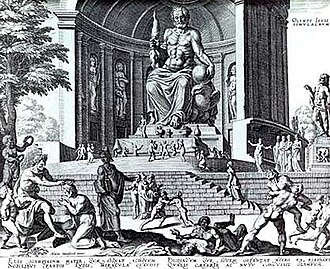Statue of Zeus at Olympia
The Statue of Zeus at Olympia was a giant seated figure, about 42 ft (13 m) tall,[1] made by the Greek sculptor Phidias around 435 BC at the sanctuary of Olympia, Greece, and erected in the Temple of Zeus there. Asculpture of ivory plates and gold panels over a wooden framework, it represented the god Zeus sitting on an elaborate cedar wood throne ornamented with ebony, ivory, gold and precious stones. It was regarded as one of theSeven Wonders of the Ancient World until its eventual loss and destruction during the 5th century AD.[2] No copy of the statue has ever been found, and details of its form are known only from ancient Greek descriptions and representations on coins.
Description[edit]
The great seated statue as fashioned by Phidias occupied half the width of the aisle of the temple built to house it. "It seems that if Zeus were to stand up," the geographer Strabo noted early in the 1st century BC, "he would unroof the temple."[3] The Zeus was a chryselephantine sculpture, made with ivory and gold panels on a wooden substructure. No copy in marble or bronze has survived, though there are recognizable but only approximate versions on coins of nearby Elis and on Roman coins and engraved gems.[4]
In the 2nd century AD, the geographer and traveler Pausanias gave a detailed description. The statue was crowned with a sculpted wreath of olive sprays. It had gold sandals, and a golden robe carved with animals and lilies. In its right hand was a small chryselephantine statue of crowned Nike, goddess of victory. Its left hand held a sceptre inlaid with many metals, supporting an eagle. The throne was decorated in gold, precious stones, ebony, and ivory.[5] According to the Roman historian Livy, the Roman general Aemilius Paulus (the victor over Macedon) saw the statue and “was moved to his soul, as if he had seen the god in person,”[6] while the 1st century AD Greek orator Dio Chrysostom declared that a single glimpse of the statue would make a man forget all his earthly troubles.[7]
According to a legend, when Phidias was asked what inspired him—whether he climbed Mount Olympus to see Zeus, or whether Zeus came down from Olympus so that Phidias could see him—the artist answered that he portrayed Zeus according to Book One, verses 528 – 530 of Homer's Iliad: [8]
-
- ἦ καὶ κυανέῃσιν ἐπ' ὀφρύσι νεῦσε Κρονίων
- ἀμβρόσιαι δ' ἄρα χαῖται ἐπερρώσαντο ἄνακτος
- κρατὸς ἀπ' ἀθανάτοιο μέγαν δ' ἐλέλιξεν Ὄλυμπον.
-
- He spoke, the son of Cronos, and nodded his head with the dark brows,
- and the immortally anointed hair of the great god
- swept from his divine head, and all Olympos was shaken.[9]
The sculptor also was reputed to have immortalised his eromenos, Pantarkes, by carving "Pantarkes kalos" into the god's little finger, and placing a relief of the boy crowning himself at the feet of the statue.[10]
Loss and destruction[edit]
According to Suetonius, the Roman Emperor Caligula "gave orders that such statues of the gods as were especially famous for their sanctity or for their artistic merit, including that of Zeus at Olympia, should be brought from Greece, in order to remove their heads and put his own in their place."[11] Before this could happen, the emperor was assassinated (AD 41); his "approaching murder was foretold by many prodigies. The statue of Jupiter at Olympia, which he had ordered to be taken to pieces and moved to Rome, suddenly uttered such a peal of laughter that the scaffolding collapsed and the workmen took to their heels."[12]
The circumstances of the statue's eventual destruction are unknown. The 11th-century Byzantine historian Georgios Kedrenos records a tradition that it was carried off to Constantinople, where it was destroyed in the great fire of theLauseion, in AD 475. Alternatively, it perished along with the temple, which burned down in AD 425.[13] Earlier loss or damage is implied by Lucian of Samosata in the later 2nd century;[14] "they have laid hands on your person at Olympia, my lord High-Thunderer, and you had not the energy to wake the dogs or call in the neighbours; surely they might have come to the rescue and caught the fellows before they had finished packing up the loot."[15]
Phidias' workshop[edit]
The approximate date of the statue (the third quarter of the 5th century BC), was confirmed in the rediscovery (1954–1958) of Phidias' workshop, sited more or less where Pausanias said the statue of Zeus was constructed. Archaeological finds included tools for working gold and ivory, ivory chippings, precious stones and terracotta moulds. Most of the latter were used to create glass plaques, and to form the statue's robe from sheets of glass, naturalistically draped and folded, then gilded. A cup inscribed "Ανήκω σε Φειδία" or "I belong to Phidias" was found at the site.





No comments:
Post a Comment